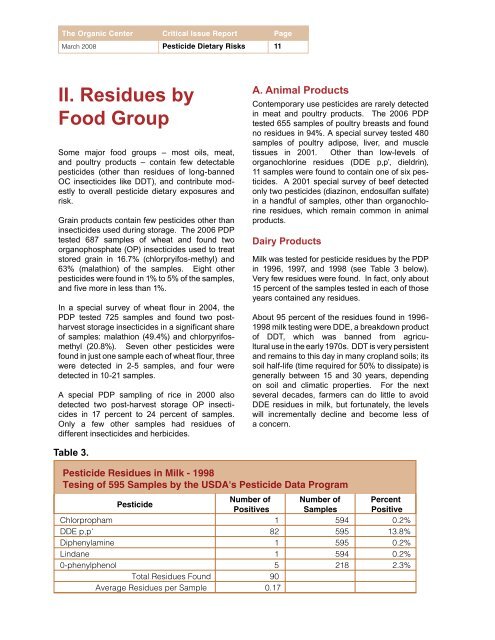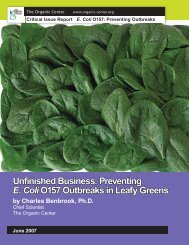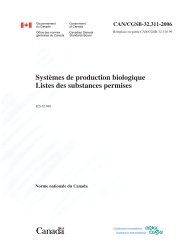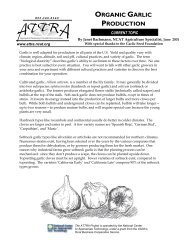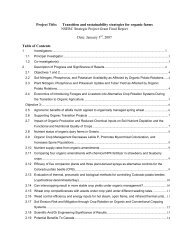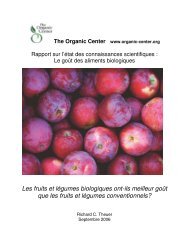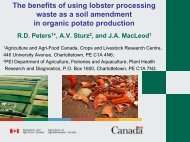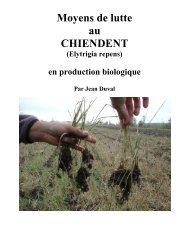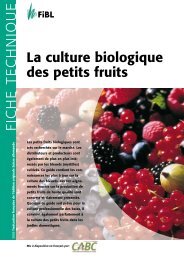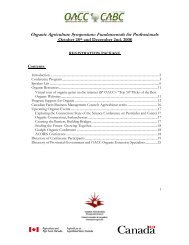The Organic Option - Centre d'agriculture biologique du Canada
The Organic Option - Centre d'agriculture biologique du Canada
The Organic Option - Centre d'agriculture biologique du Canada
You also want an ePaper? Increase the reach of your titles
YUMPU automatically turns print PDFs into web optimized ePapers that Google loves.
<strong>The</strong> <strong>Organic</strong> Center Critical Issue Report Page<br />
March 2008 Pesticide Dietary Risks 11<br />
II. Resi<strong>du</strong>es by<br />
Food Group<br />
Some major food groups – most oils, meat,<br />
and poultry pro<strong>du</strong>cts – contain few detectable<br />
pesticides (other than resi<strong>du</strong>es of long-banned<br />
OC insecticides like DDT), and contribute modestly<br />
to overall pesticide dietary exposures and<br />
risk.<br />
Grain pro<strong>du</strong>cts contain few pesticides other than<br />
insecticides used <strong>du</strong>ring storage. <strong>The</strong> 2006 PDP<br />
tested 687 samples of wheat and found two<br />
organophosphate (OP) insecticides used to treat<br />
stored grain in 16.7% (chlorpryifos-methyl) and<br />
63% (malathion) of the samples. Eight other<br />
pesticides were found in 1% to 5% of the samples,<br />
and five more in less than 1%.<br />
In a special survey of wheat flour in 2004, the<br />
PDP tested 725 samples and found two postharvest<br />
storage insecticides in a significant share<br />
of samples: malathion (49.4%) and chlorpyrifosmethyl<br />
(20.8%). Seven other pesticides were<br />
found in just one sample each of wheat flour, three<br />
were detected in 2-5 samples, and four were<br />
detected in 10-21 samples.<br />
A special PDP sampling of rice in 2000 also<br />
detected two post-harvest storage OP insecticides<br />
in 17 percent to 24 percent of samples.<br />
Only a few other samples had resi<strong>du</strong>es of<br />
different insecticides and herbicides.<br />
A. Animal Pro<strong>du</strong>cts<br />
Contemporary use pesticides are rarely detected<br />
in meat and poultry pro<strong>du</strong>cts. <strong>The</strong> 2006 PDP<br />
tested 655 samples of poultry breasts and found<br />
no resi<strong>du</strong>es in 94%. A special survey tested 480<br />
samples of poultry adipose, liver, and muscle<br />
tissues in 2001. Other than low-levels of<br />
organochlorine resi<strong>du</strong>es (DDE p,p’, dieldrin),<br />
11 samples were found to contain one of six pesticides.<br />
A 2001 special survey of beef detected<br />
only two pesticides (diazinon, endosulfan sulfate)<br />
in a handful of samples, other than organochlorine<br />
resi<strong>du</strong>es, which remain common in animal<br />
pro<strong>du</strong>cts.<br />
Dairy Pro<strong>du</strong>cts<br />
Milk was tested for pesticide resi<strong>du</strong>es by the PDP<br />
in 1996, 1997, and 1998 (see Table 3 below).<br />
Very few resi<strong>du</strong>es were found. In fact, only about<br />
15 percent of the samples tested in each of those<br />
years contained any resi<strong>du</strong>es.<br />
About 95 percent of the resi<strong>du</strong>es found in 1996-<br />
1998 milk testing were DDE, a breakdown pro<strong>du</strong>ct<br />
of DDT, which was banned from agricultural<br />
use in the early 1970s. DDT is very persistent<br />
and remains to this day in many cropland soils; its<br />
soil half-life (time required for 50% to dissipate) is<br />
generally between 15 and 30 years, depending<br />
on soil and climatic properties. For the next<br />
several decades, farmers can do little to avoid<br />
DDE resi<strong>du</strong>es in milk, but fortunately, the levels<br />
will incrementally decline and become less of<br />
a concern.<br />
Table 3.<br />
Pesticide Resi<strong>du</strong>es in Milk - 1998<br />
Tesing of 595 Samples by the USDA's Pesticide Data Program<br />
Pesticide<br />
Number of Number of Percent<br />
Positives Samples Positive<br />
Chlorpropham 1 594 0.2%<br />
DDE p,p' 82 595 13.8%<br />
Diphenylamine 1 595 0.2%<br />
Lindane 1 594 0.2%<br />
0-phenylphenol 5 218 2.3%<br />
Total Resi<strong>du</strong>es Found 90<br />
Average Resi<strong>du</strong>es per Sample 0.17


